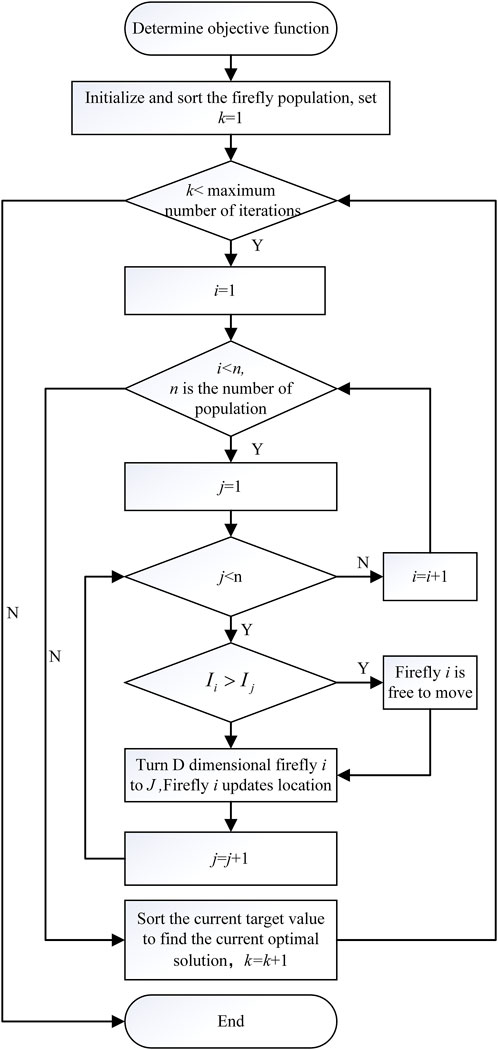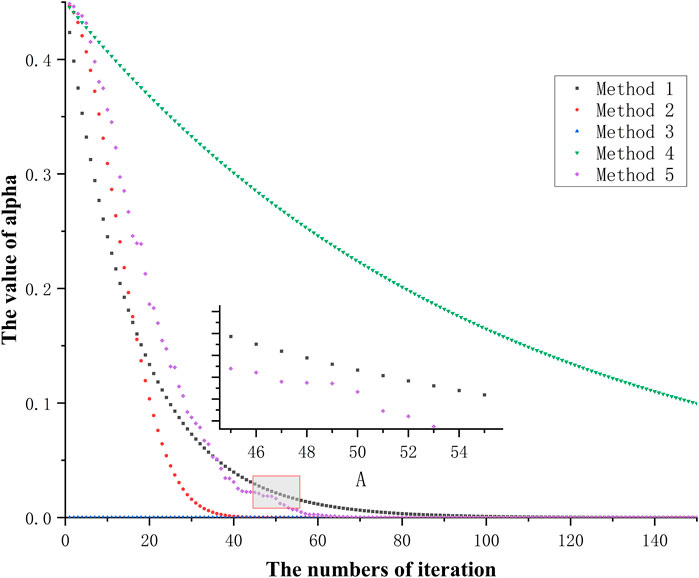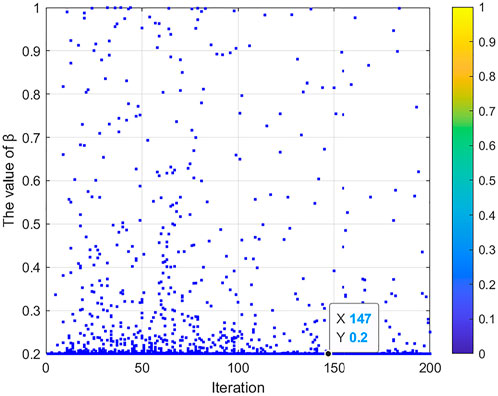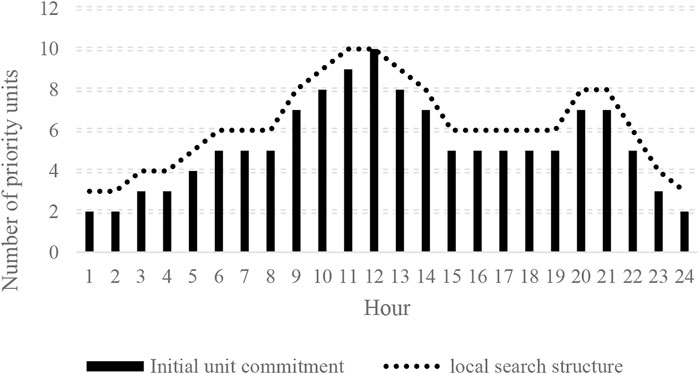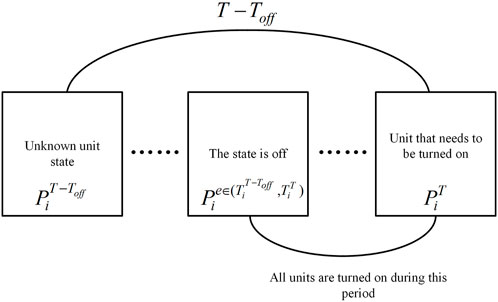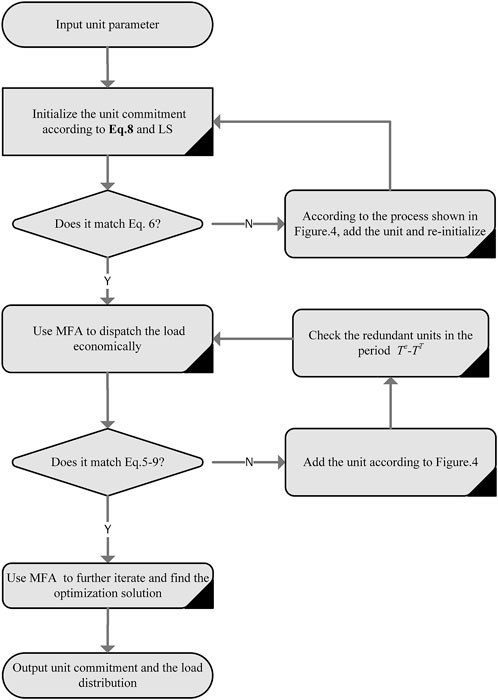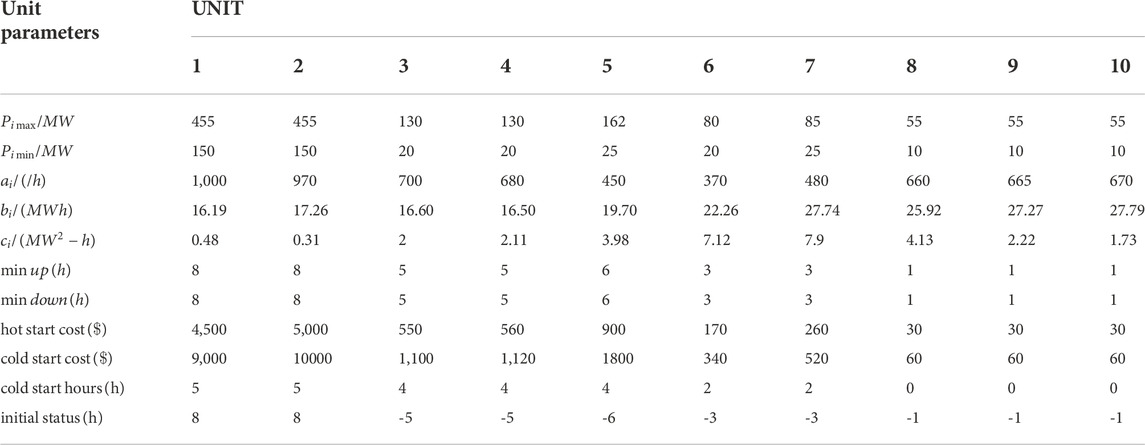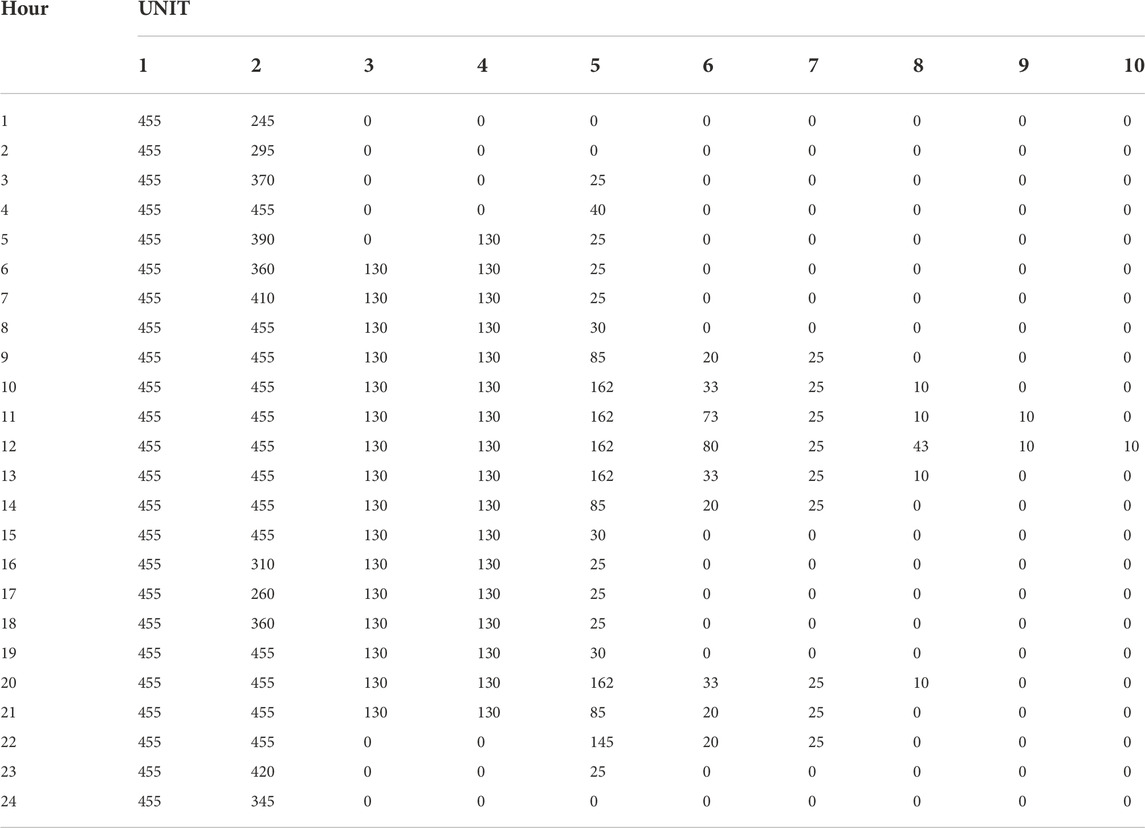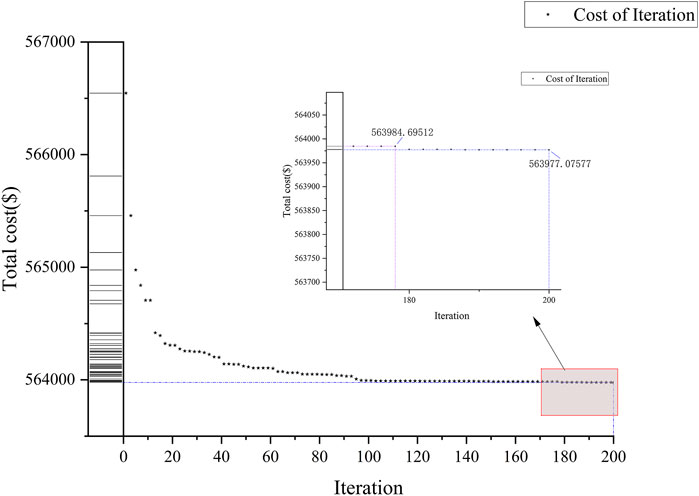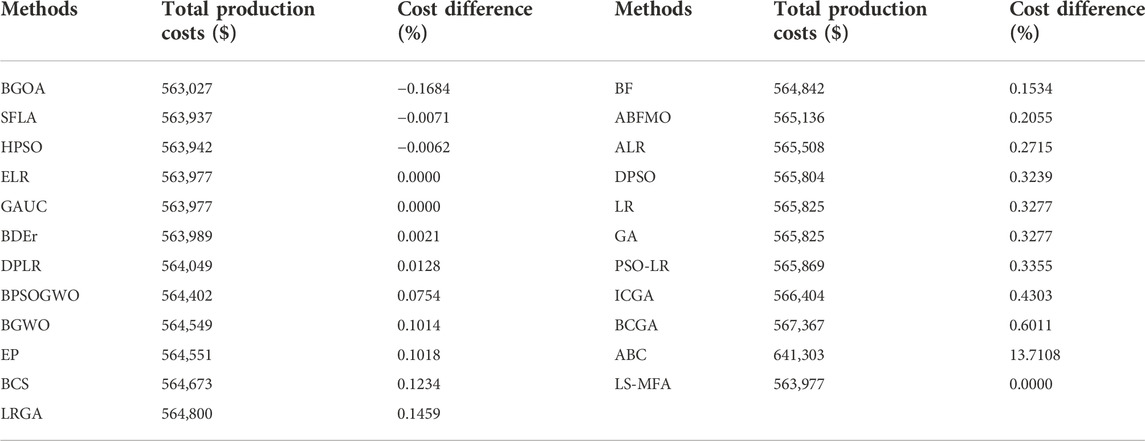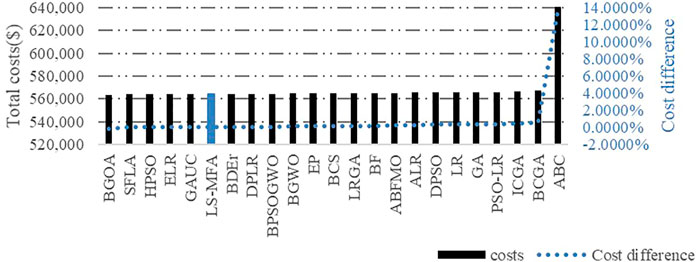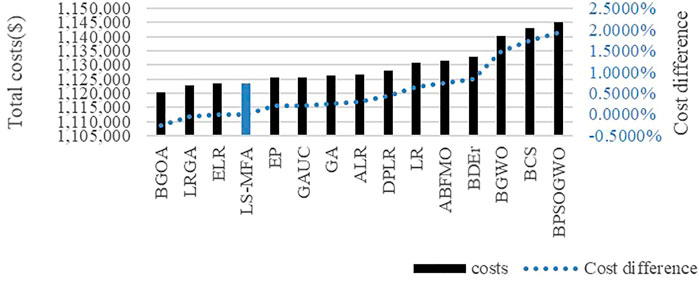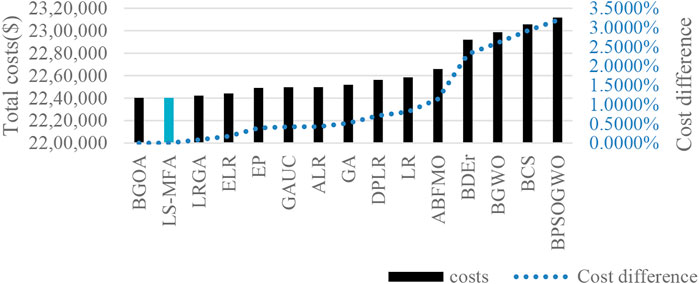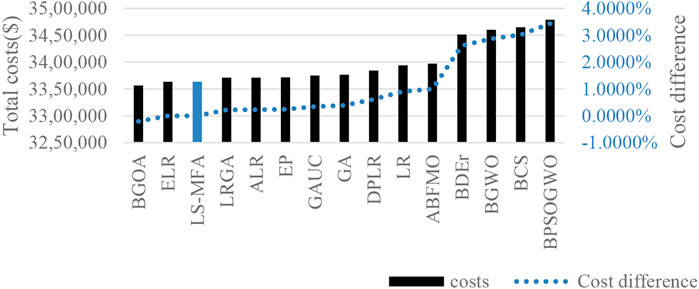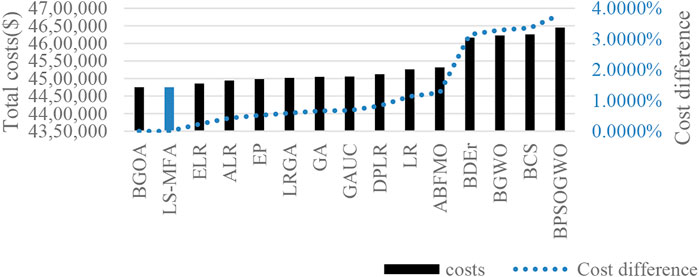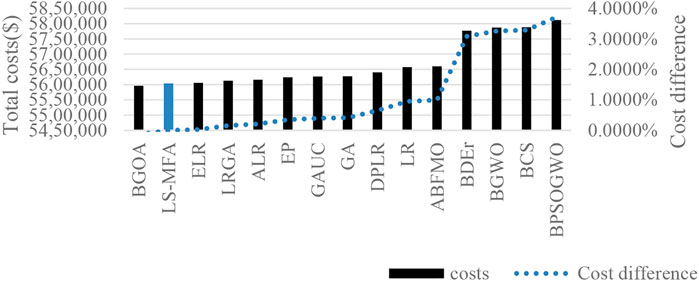- 1Key Laboratory of Power System Optimization and Energy Saving Technology, Guangxi University, Nanning, China
- 2School of Economics and Management, Guangxi Agricultural Vocational and Technical University, Nanning, China
The Unit Commitment problem (UC) is a complex mixed-integer nonlinear programming problem, so the main challenge faced by many researchers is obtaining the optimal solution. Therefore, this dissertation proposes a new methodology combining the multi-dimensional firefly algorithm with local search called LS-MFA and utilizes it to solve the UC problem. In addition, adaptive adjustment, tolerance mechanism, and pit-jumping random strategy help to improve the optimal path and simplify the redundant solutions. The experimental work of unit commitment with the output of 10–100 machines in the 24-hour period is carried out in this paper. And it shows that compared with the previous UC artificial intelligence algorithms, the total cost obtained by LS-MFA is less and the results are excellent.
1 Introduction
The electric power industry is becoming a key instrument in the economic and social development of a nation. It plays a vital role in the heavy industry and has long been the leading industry of a nation. With the continuous progress of human society and civilization, the power system has penetrated into all walks of life, so the effective, economic, secure, and stable operation of the power system has emerged as a powerful platform for the economic development of the nation. From national defence to daily life, the stability and reliability of the power system have been escorting social progress. There are some pieces of evidence to suggest that with the continuous expansion of the power system scale, it is challenging to achieve the balance of supply and demand and maximize economic benefits only by governing the output and commitment of the generators, which needs to adjust generators unit commitment and output scheduling in advance.
The unit commitment of a power system refers to reasonably adjusting the up-down state of units and active power distribution of units in a specified period (the example selected in this paper is a 24-hour period), so as to satisfy the balance between supply, demand, and spinning reserve requirement. And it can maximize the economic benefits of power system operation.
Among the traditional algorithms, literature (Su and Hsu, 1991) adopted fuzzy optimization theory to express load prediction, operation cost, and spinning reserve. They designed a fuzzy dynamic programming approach. One criticism of the literature was that it took a long time. A combination of the genetic algorithm and the quadratic programming approach was used in the literature (Mantawy, 1998) based on fuzzy optimization theory to obtain the unit commitment. Literature (Senjyu et al., 2003) based on heuristic methods provided a means of solving the problem of unit commitment, which improved the effectiveness of the algorithm. Dynamic programming was adopted in literature (Lee, 1991), and the average full-load consumption combined with the unit operation factor was selected for its reliability and validity. To better improve the accuracy of the solution, reference (Fan et al., 1996) undertook the sequential input method. Later, the exit commitment algorithm appeared. In literature (Xia et al., 2000), the use of reversing sorting according to the variation of unit operating cost after the unit shutdown was a well-established approach to finding the optimal solution. Besides, many researchers (Lowery, 1966; van den Bosch and Honderd, 1985; Snyder et al., 1987) have utilized the dynamic planning method to solve the problem of UC, but a major problem with the experimental method was the dimension disaster. So the procedures of this study were enhanced by the central improvement idea. That was to initialize the unit according to some economic characteristics indexes to generate the initial unit commitment, which greatly reduced the state variables. The Lagrangian Relaxation method (LR) was one of the most prominent procedures for determining commitment (Merlin and Sandrin, 1983; Zhuang and Galiana, 1988; Cohen et al., 1999) The benefit of this approach was that there was no dimension of disaster, and it performed well in solving large-scale optimization problems. However, there were certain drawbacks associated with the use of LR, for example, the convergence speed was not fast, and it appeared to oscillate. Literature (Carrión and Arroyo, 2006; Ostrowski et al., 2012) adopted a mixed integer programming method, but this method usually had no requirements on constraint conditions and a large amount of calculation, with slow calculation speed and convergence speed, so its practicability was not outstanding.
Recently, publications about UC more frequently adopted the artificial intelligence algorithm. Literature (Sasaki et al., 1992) depended on the Hopfield network model in Artificial Neural Networks (ANN) to solve the UC problem. Analysis of Hopfield involved in the traditional algorithm was first carried out. Various inequality constraints were taken into account in detail to determine the up-down state of each unit. But the model failed in convergence, and the results were not accurate. In 1996, Bai et al. published a paper in which they described the Tabu Algorithm (TB) to design a method that can be used for day-ahead scheduling plan adjustment or plan reorganization after the change of system running state (Bai and Shahidehpour, 1996). In an attempt to have good robustness and good calculation speed, the researcher (Maifeld and Sheble, 1996; Srinivasan and Tettamanzi, 1996) used the Genetic Algorithm (GA). Literature (Wong, 1998) used simulated annealing, which was a heuristic random algorithm based on Monte Carlo Iterative Solution Algorithm, but its convergence speed was behindhand, and some control parameters were difficult to determine.
This paper focuses on an artificial intelligence algorithm—Firefly Algorithm (FA) which eradicates the old and fosters the new. The FA was designed by Yang of Cambridge University in 2009 (Yang, 2009). It simulates the unique social behavior of fireflies in nature—luminous. And it generates a random optimization algorithm. Firefly Algorithm not only has a simple procedure, but also less relevant data, even can better overcome the common problem of local fast convergence of artificial intelligence algorithms. Therefore, this algorithm is beloved when it solves complex optimization problems with multiple constraints. The Firefly Algorithm is a random optimization algorithm generated according to the characteristics of the firefly’s flashing behavior in nature. Without considering the biological significance of the firefly’s luminescence, the firefly only uses its luminescence characteristics to search for companions in its search area and advances toward individuals with a higher brightness than itself to complete the update of the position. Firefly Algorithm was first carried out in 2005 at the IEEE conference on Swarm Intelligence. There has been an amount of application since it was proposed, such as the use of robots in the group, looking for multiple source localization, harmful gas emissions, contamination inspection, and multimodal optimization problems (Krishnanand and Ghose, 2005, 2006; Krishnanand K. and Ghose, D. 2009; Krishnanand K. N. and Ghose, D. 2009), which show the FA has a good performance, causing the favor of the researchers around the world, gradually becomes new popular research in the intelligent computing field.
This dissertation employs the Multidimensional Firefly Algorithm combined with Local Search (Balas and Vazacopoulos, 1998) named LS-MFA to solve the UC problem, considering discrete and continuous variables, and the output of generators, the unit minimum up-down time constraints, the load constraints. Meanwhile, the ramp rate constraints are also involved, which has the system is no longer a single independent section of optimization during the run time. Instead, it is sequent, setting out to obtain the unit commitment and the unit output distribution as well as having a significant price advantage compared with the previous literature. Meanwhile, the Firefly Algorithm itself is improved, one of which is to replace the fixed movement factors of FA with a new dynamic parameter adjustment method. Otherwise, different from the modern heuristic algorithms which use a penalty function to deal with equality constraints, this article does not add an additional objective function. It engages with the tolerance mechanism and amends the infeasible solution to the feasible region, which avoids being difficult to find a feasible solution due to multifarious equality constraints in the dynamic economic dispatch (DED). Beyond that, the random strategy is adopted aiming to increase the diversity of the population and prevent local premature convergence. It is worth mentioning that this paper proposes a new methodology for dealing with discrete variables. It joins the thought of Local Search (LS) including the “jumping pit strategy”. And according to minimum up-down time limits, it sets up mandatory units that must run, mandatory units that must be turned off, and the free unit, which greatly reduces the amount of calculation of the unit commitment. Faster and more efficient optimization is achieved by adjusting free units. Furthermore, the injection of the “self-comparison” strategy ensures the rapid convergence of the search range. Frequently, compared with previous literature, the results show that LS-MFA facilitates the economy.
This paper is composed of six themed chapters. And it has begun with the above overview and introduction to UC. It will then go on to specifically introduce the proposed new methodology LS-MFA. The second part deals with the models and formulas of UC. Chapter Three begins by laying out the improvement both in the random movement factor
2 Mathematical model of UC
2.1 Objective function
The UC problem is to determine the best commitment of the unit state and generate the corresponding active power output in order to minimize the sum of power generation cost and start-up cost in the cycle. Its mathematical model is expressed as follows:
In the formula,
Where,
In the formula,
Where,
2.2 Unit input also needs to meet the following constraints
2.2.1 Supply and demand balance constraints
The equality constraint in unit commitment optimization is the active power balance constraint. The total generating capacity of the generator needs to be equal to the load in real-time.
Where,
2.2.2 Constraints on spinning reserve requirement
In order to ensure the reliability of the system, sufficient spare capacity should be left in the power system, which can be expressed as:
Where,
2.2.3 Constraints on unit operation output
Where,
2.2.4 Constraints on start and stop time
When the unit changes its state, it needs to meet a certain time, otherwise, it will threaten the normal operation of the unit, which can be expressed in the following formula:
Where,
2.2.5 Climbing and descending constraints
The formula,
3 Proposed improved LS-MFA model
3.1 Firefly algorithm
Light intensity and attractiveness are the crucial roles of FA. For mathematical expression, the position of fireflies in the space coordinates determines the brightness of the firefly, which can be described as different positions matching different brightness. Meanwhile, its relative brightness decides the attraction between the individual and the probability of attraction, for this reason, it affects the distance and the direction of the individual movement. Therefore, each individual will change its light intensity in the process of moving. Finally, all kinds of updates are completed and at the same time, the optimization of the target is completed. The mathematical expressions in this process are as follows:
3.1.1 Relative attractiveness of fireflies
Where,
3.1.2 Cartesian distance
The distance between individuals can be called Euclidean or Cartesian distance, and it can be expressed as follows:
Where,
3.1.3 Location update basis
The formula that individual
In the formula,
3.1.4 Flow chart of basic firefly algorithm
How the FA gets down evolutionary operation can be demonstrated as Figure 1
3.2 Improved firefly algorithm
3.2.1 In modifying and improving the random movement factor
In Firefly Algorithm, the random movement factor α plays an important role. If the random movement factor α is always large, the speed of optimization can be improved, but the accuracy of the solution will be reduced. If the random movement factor is always small, although the accuracy of understanding is improved, the optimization speed of the algorithm is greatly slowed down. Therefore, in the initial stage of the algorithm, α is relatively large, which can accelerate the speed of optimization. At the later stage, a relatively small step factor is needed, because, at this time, the population in the space has been mostly concentrated near the optimal solution, and a small step factor can improve the accuracy of the solution. Therefore, we need to adopt dynamic α to adjust the optimization.
In literature (Zhang et al., 2017), Zhang constructed a Firefly Algorithm with adaptive step size. The paper pointed out that under ideal conditions, all individuals in the population would gradually converge to the same point and eventually converge during the optimization process. That is, for two individuals
Where,
Where, Eq. 15 shows that when the firefly algorithm converges, the random movement factor
Therefore, this paper adopts Eq. 16 to dynamically update the random movement factor
From Figure 2, we can see that its value gradually decreases and tends to zero with the number of iterations, which is in line with the inference of the above formula. Meanwhile, the following calculation examples show that the improved method can help us find the optimal solution.
At the same time, another four different
It can be seen from Figure 2 that M2 converges too fast, resulting in too short step factor and local premature maturation. The initial stage of M3 is too small and the optimization range is too small, which is not conducive to population diversity. M4 converges too slowly, so that the step size factor in the final stage is too large, resulting in slow convergence. From the local enlarged image, M5 has a random term, which makes the float and unstable changes. Therefore, M1 is the correct choice in this paper, which ensures better convergence and relatively stable.
3.2.2 In terms of improving the attractiveness
According to previous studies, it is found that the optimization result of the algorithm is not so satisfactory when the algorithm is based on Eq. 10. To deal with this phenomenon, many change strategies have been proposed by researchers, among which the most well-known is the change mechanism proposed by Fister et al. (Fister et al., 2012). The improvement in this example is shown in Figure 3, and the formula can be expressed as follows:
As can be seen from Figure 3, in the optimization of the whole stage, the values of attractiveness remain at around 0.2, but there are a few times that the attractiveness reaches 1, ensuring the diversity of the population, avoiding excessive prematurity, meanwhile, as progress through the iteration is smooth, this is because most of the fireflies are already clustered around the brightest individuals in the space. Most of the attraction converges at about 0.2, which is conducive to improving the convergence rate of the population.
3.3 Combine local search
Local Search is a simple, efficient, and fast local search algorithm. A local search is constructed for the unit commitment problem, and a local adjustment method is created to ensure that the final result obtained by the algorithm can satisfy all the constraints and to ensure the feasibility of the optimization results.
In this essay, the Local Search method is used to solve the discrete variable problem of unit commitment. Firstly, according to Eq. 8, mandatory units that must be turned on, mandatory units that must be turned off, and the free units are determined. If
There are many indexes to measure the unit input sequence, and different parameter indexes can be selected according to the characteristics of different units and loads. In this paper, based on the minimum specific consumption, Eq. 23 is used as the ranking index of units that are free:
According to the Eq. 6 to form the initial unit commitment, but in the process, to take into account for a certain period that the load is too heavy or subsequent unit start-up costs are too expensive to open, it is necessary to include opening a mandatory unit that must be turned off, to meet the requirements of load and the spinning reserve. While combining with the economic dispatch followed considering ramp rates constraints, it can appear that it does not satisfy Eq. 6. Therefore, to simplify the calculation, this paper first forms the bandwidth of an upward expansion unit, as shown in Figure 4. If the unit in sequence willing turn on is a mandatory unit that must be turned off, it is necessary to find the stopped time during the
4 Application of LS-MFA in solving unit commitment problems
4.1 Bionic model of unit commitment problem
In this paper, fireflies in the population represent the unit output commitment of
Firefly position updates are made by the following formula:
Where:
4.2 Flow chart of the solving process
The flow chart of the optimization solving process can be shown in Figure 6.
Step 1. The unit parameters, load, and spinning reserve requirement are the first input.
Step 2. The initial unit commitment is determined according to the maximum unit output, Eq. 8, and the method of local structure construction, and whether it meets the load and spinning reserve requirement of the unit is considered, i.e. Eq. 6. If Eq.6 is satisfied, go to Step 4.
Step 3. If not, according to the process shown in Figure 4 and Eq. 8, restarting the units in the previous period makes the units will be opened into units to be available, and initialize the firefly population of the reopened units again to eliminate redundant units. Then repeat Step 2.
Step 4. When Eq. 6 is met, MFA is used to carry out economic dispatch corresponding to this unit commitment. However, since ramp rate limits should be considered in the process of economic dispatch, other units in the same segment need to be opened again to meet the load and spinning reserve requirement. Therefore, if Eqs 5–9 is not satisfied, go to Step 5, otherwise, go to Step 6.
Step 5. In this step, Figure 4 should be used again. Initialize the firefly population of the reopened units again to eliminate redundant units, until the units satisfy Eqs 5–9 again. Then, repeat Step.4.
Step 6. In this step, MFA is used to further optimize the iteration of the population, including unit commitment and economic dispatch, and the “self-comparison” strategy is used to prevent the iteration from deviating from the optimal value.
5 Simulation results and analysis
In this essay, the example of 10 units in literature (Kazarlis et al., 1996) for a 24-hour period is first adopted. The unit parameters are provided in Table 1, which includes the maximum active power output of the unit
With the aim of presenting the optimization process, Figure 7 shows the trend of 200 iterations of the optimization process. From the figure, the results have been smooth around the 100th iteration. And it can be seen from the whisker diagram of the ordinate axis, that in the initial iterations of the optimization, convergence speed is quick, and most of the results are concentrated around the optimal solution, this phenomenon also confirms the improvement in both in the random movement factor
In order to further illustrate the advantages and practicability of LS-MFA, the clustering results of the other twenty-two methods of DPLR, ALR, ELR (Ongsakul and Petcharaks, 2004), LR, GA (Kazarlis et al., 1996),EP (Juste, 1999), LRGA (Cheng and Liu, 2000), GAUC(Yamashiro, 2001), DPSO(Gaing, 2004), ICGA, BCGA(Damousis et al., 2004), BF(Eslamian et al., 2009), PSO-LR (Balci and Valenzuela, 2004), SLFA (Ebrahimi et al., 2011), HPSO(Ting et al., 2006), BGOA (Shahid et al., 2021), ABC(Kokare and Tade, 2018), ABFMO(Pan et al., 2021), BCS(Reddy Surender, 2017), BDEr (Kamboj et al., 2017), BGWO(Panwar et al., 2018), BPSOGWO(Kamboj, 2016) which are shown in Table 5, meanwhile, the results are compared with the result of LS-MFA, obtaining the cost difference. Figure 8 visualizes the comparison, ranking several methods using operating costs as the primary axis (black) and cost differences (blue) as the secondary axis. By checking the output obtained from SLFA, whose cost is better than LS-MFA, we find that although the cost is 563937$, it does not meet the load demand in the period of
In order to further demonstrate the good performance of LS-MFA, the 20,40,60,80,100-unit systems are used to verify. The 20, 40, 60, 80, and 100-unit data are obtained by duplicating the base case (ten units), whereas the load demands are adjusted in proportion to the system size. And the comparisons of the larger systems are shown in. Meanwhile, for a more intuitive comparison, the methods are sorted. Figures 9–13 visualize the comparison, ranking several methods using operating costs as the primary axis (black) and cost differences (blue) as the secondary axis. Figures 10, 12 present that LS-MFA acquires the best data in 40-unit and 80-unit.
As can be seen by the above results, the result obtained by LS - MFA is better than most methods, and in the process of optimization, compared with the mixed-integer nonlinear programming, the use of local search avoids the dimension disaster, and improves convergence speed. Meanwhile, few parameters using the firefly algorithm program and strong randomness make the optimization not too premature and effectively prevent the local convergence. The improvement of the Firefly algorithm itself makes the final results tend to be stable, and the results obtained are well.
6 Conclusions and future work
In the process of the optimization problem of the power system, the unit commitment problem is always the top priority. And its economic dispatch power system is efficient, safe, stable, and economic operation indispensable safeguard. By finding the optimum commitment, the electric power industry of a country can not only get considerable income but also alleviate the problems of energy shortage and environmental pollution in today’s era. Meanwhile, it is a powerful catalyst to promote the implementation of sustainable a development strategy.
Unit Commitment of electric power system and the economic dispatch problem is discrete and continuous variables of the nonconvex, nonlinear, multi-dimensional. Besides, the distribution of the process is complex. Therefore, only set up accurate realistic models of the actual working state of the power grid, can we obtain more conducive for the further optimization and development of the power system. The focus of this paper lies in:
1) Use dynamic
2) The self-adjustment strategy is used to prevent the target value from deviating from the optimal solution due to iteration.
3) A tolerance mechanism was adopted to modify the infeasible solution to the feasible region and increase the population diversity.
4) Combined with the Local Search method, the “pit-jumping strategy” is adopted to determine the unit commitment, which not only ensures the diversity of unit commitment solutions but also avoids dimension disaster to a certain extent.
5) The Firefly Algorithm combined with the Local Search method can be found through the simulation results that its unit commitment and economic dispatch results are not inferior to other algorithms
In the future, the author will strive to improve LS-MFA and add an integrated energy management system, including combining heat and power generation (CHP), wind and hydropower units, and battery energy storage systems, so as to make it meet the modern energy needs.
In recent years, the living level has continuously improved, and people are no longer taking the environmental problem for granted, we must adhere to the new concept of development, sustainable development. So when solving the UC problem, the power system should not only consider whether or not the operation efficiency, the cost is considerable, and incorporated into the new energy. Beyond that, some uncontrollable factors should be taken into account, such as inaccurate load prediction, failure of output unit start and stop, accidents in the transmission process, and the probability of interference factors that may occur. And finally, the objective function and each constraint probability are calculated to build a scheduling model in line with the actual operation situation. That is, to say, the premise of our pursuit of economic benefits is to protect nature and build an energy-conserving society.
Data availability statement
The original contributions presented in the study are included in the article/supplementary material, further inquiries can be directed to the corresponding author.
Author contributions
All authors listed have made a substantial, direct, and intellectual contribution to the work and approved it for publication.
Funding
This work was supported in part by the Guangxi Special Fund for Innovation-Driven Development under Grant AA19254034 and in part by Guangxi Key Laboratory of Power System Optimization and Energy Technology Research Grant.
Conflict of interest
The authors declare that the research was conducted in the absence of any commercial or financial relationships that could be construed as a potential conflict of interest.
Publisher’s note
All claims expressed in this article are solely those of the authors and do not necessarily represent those of their affiliated organizations, or those of the publisher, the editors and the reviewers. Any product that may be evaluated in this article, or claim that may be made by its manufacturer, is not guaranteed or endorsed by the publisher.
References
Bai, X., and Shahidehpour, S. M. (1996). Hydro-thermal scheduling by tabu search and decomposition method. IEEE Trans. Power Syst. 11, 968–974. doi:10.1109/59.496182
Balas, E., and Vazacopoulos, A. (1998). Guided local search with shifting bottleneck for job shop scheduling. Manage. Sci. 44, 262–275. doi:10.1287/mnsc.44.2.262
Balci, H. H., and Valenzuela, J. F. (2004). Scheduling electric power generators using particle swarm optimization combined with the Lagrangian relaxation method. Int. J. Appl. Math. Comput. Ence. 2004, 411–442.
Carrión, M., and Arroyo, J. M. (2006). A computationally efficient mixed-integer linear formulation for the thermal unit commitment problem. IEEE Trans. Power Syst. 21, 1371–1378. doi:10.1109/TPWRS.2006.876672
Cheng, C. P., and Liu, C. W. (2000). Unit commitment by Lagrangian relaxation and genetic algorithms. IEEE Trans. Power Syst. 15, 707–714. doi:10.1109/59.867163
Cohen, A. I., Brandwahjn, V., and Chang, S. K. (1999). “Security constrained unit commitment for open markets,” in Proceedings of the 21st International Conference on Power Industry Computer Applications. Connecting Utilities. PICA 99. To the Millennium and Beyond (Cat. No.99CH36351), Santa Clara, CA, USA, 21-21 May 1999 (IEEE).
Damousis, I. G., Bakirtzis, A. G., and Dokopoulos, P. S. (2004). A solution to the unit-commitment problem using integer-coded genetic algorithm. IEEE Trans. Power Syst. 19, 1165–1172. doi:10.1109/TPWRS.2003.821625
Ebrahimi, J., Hosseinian, S. H., and Gharehpetian, G. B. (2011). Unit commitment problem solution using shuffled frog leaping algorithm. IEEE Trans. Power Syst. 26, 573–581. doi:10.1109/TPWRS.2010.2052639
Eslamian, M., Hosseinian, S. H., and Vahidi, B. (2009). Bacterial foraging-based solution to the unit-commitment problem. IEEE Trans. Power Syst. 24, 1478–1488. doi:10.1109/TPWRS.2009.2021216
Fan, J. Y., Zhang, M. L., and McDonzjd, M. J. D. (1996). Enhanced techniques on sequential unit commitment with interchange transactions. IEEE Trans. Power Syst. 11, 93–100. doi:10.1109/59.485990
Fister, I., Fister, I., Brest, J., and Yang, X. S. (2012). Memetic firefly algorithm for combinatorial optimization. Proc. 5th Int. Conf. Bioinspired Optim. Methods their Appl. BIOMA 2012, 75–86. doi:10.48550/arXiv.1204.5165
Gaing, Z. L. (2004). “Discrete particle swarm optimization algorithm for unit commitment,” in 2003 IEEE Power Engineering Society General Meeting (IEEE Cat. No.03CH37491), Toronto, ON, Canada, 13-17 July 2003 (IEEE). doi:10.1109/PES.2003.1267212
Juste, K. A., Kita, H., Tanaka, E., and Hasegawa, J. (1999). An evolutionary programming solution to the unit commitment problem. IEEE Trans. Power Syst. 14, 1452–1459. doi:10.1109/59.801925
Kamboj, V. K. (2016). A novel hybrid PSO–GWO approach for unit commitment problem. Neural comput. Appl. 27, 1643–1655. doi:10.1007/s00521-015-1962-4
Kamboj, V. K., Bath, S. K., and Dhillon, J. S. (2017). A novel hybrid DE–random search approach for unit commitment problem. Neural comput. Appl. 28, 1559–1581. doi:10.1007/s00521-015-2124-4
Kazarlis, S. A., Bakirtzis, A. G., and Petridis, V. (1996). A genetic algorithm solution to the unit commitment problem. IEEE Trans. Power Syst. 11, 83–92. doi:10.1109/59.485989
Kokare, M. B., and Tade, S. V. (2018). “Application of artificial bee colony method for unit commitment,” in Proc. - 2018 4th Int. Conf. Comput. Commun. Control Autom. ICCUBEA, Pune, India, 16-18 August 2018 (IEEE). doi:10.1109/ICCUBEA.2018.8697562
Krishnanand, K., and Ghose, D. (2009a). A glowworm swarm optimization based multi-robot system for signal source localization. Stud. Comput. Intell. 177, 89933. doi:10.1007/978-3-540-89933-4_3
Krishnanand, K., and Ghose, D. (2005). “Detection of multiple source locations using a firefly metaphor with applications to collective robotics,” in Swarm Intelligence Symposium, 2005. SIS 2005, Pasadena, CA, United States, June 8–10, 2005 (Proceedings 2005 IEEE (IEEE)). doi:10.1109/SIS.2005.1501606
Krishnanand, K., and Ghose, D. (2006). Glowworm swarm based optimization algorithm for multimodal functions with collective robotics applications. Multiagent Grid Syst. 2, 209–222. doi:10.3233/MGS-2006-2301
Krishnanand, K. N., and Ghose, D. (2009b). Glowworm swarm optimisation: A new method for optimising multi-modal functions. Int. J. Comput. Intell. Stud. 1, 93. doi:10.1504/ijcistudies.2009.025340
Lee, F. N. (1991). The application of commitment utilization factor (CUF) to thermal unit commitment. IEEE Power Eng. Rev. 11, 66. doi:10.1109/MPER.1991.90627
Lowery, P. G. (1966). Generating unit commitment by dynamic programming. IEEE Trans. Power Apparatus Syst. 85, 422–426. doi:10.1109/TPAS.1966.291679
Maifeld, T. T., and Sheble, G. B. (1996). Genetic-based unit commitment algorithm. IEEE Trans. Power Syst. 11, 1359–1370. doi:10.1109/59.536120
Mantawy, A. H., Abdel-Magid, Y., and Selim, S. (1998). A simulated annealing algorithm for unit commitment. IEEE Trans. Power Syst. 13, 197–204. doi:10.1109/59.651636
Merlin, A., and Sandrin, P. (1983). A new method for unit commitment at electricite de France. IEEE Trans. Power Appar. Syst. 102, 1218–1225. doi:10.1109/TPAS.1983.318063
Ongsakul, W., and Petcharaks, N. (2004). Unit commitment by enhanced adaptive Lagrangian relaxation. IEEE Trans. Power Syst. 19, 620–628. doi:10.1109/TPWRS.2003.820707
Ostrowski, J., Anjos, M. F., and Vannelli, A. (2012). Tight mixed integer linear programming formulations for the unit commitment problem. IEEE Trans. Power Syst. 27, 39–46. doi:10.1109/TPWRS.2011.2162008
Pan, J. S., Hu, P., and Chu, S. C. (2021). Binary fish migration optimization for solving unit commitment. Energy 226, 120329. doi:10.1016/j.energy.2021.120329
Panwar, L. K., Reddy, K. S., Verma, A., Panigrahi, B. K., and Kumar, R. (2018). Binary Grey Wolf Optimizer for large scale unit commitment problem. Swarm Evol. Comput. 38, 251–266. doi:10.1016/j.swevo.2017.08.002
Reddy Surender, S. (2017). Optimal reactive power scheduling using cuckoo search algorithm. Int. J. Electr. Comput. Eng. 7, 2349. doi:10.11591/ijece.v7i5.pp2349-2356
Sasaki, H., Watanabe, M., Kubokawa, J., Yorino, N., and Yokoyama, R. (1992). A solution method of unit commitment by artificial neural networks. IEEE Trans. Power Syst. 7, 974–981. doi:10.1109/59.207310
Senjyu, T., Shimabukuro, K., Uezato, K., and Funabashi, T. (2003). A fast technique for unit commitment problem by extended priority list. IEEE Trans. Power Syst. 18, 882–888. doi:10.1109/TPWRS.2003.811000
Shahid, M., Malik, T. N., and Said, A. (2021). Heuristic based binary grasshopper optimization algorithm to solve unit commitment problemEff. hybrid Part. swarm Optim. Turk. J. Elec. Eng. Comp. Sci.IEEE Trans. Power Syst. 2921 (2121), 944411411–961418418. doi:10.3906/elk-2004-144
Snyder, W. L., Powell, H. D., and Rayburn, J. C. (1987). Dynamic programming approach to unit commitment. IEEE Trans. Power Syst. 2, 339–348. doi:10.1109/TPWRS.1987.4335130
Srinivasan, D., and Tettamanzi, A. (1996). Heuristics-guided evolutionary approach to multi-objective generation scheduling. IEE Proc. Gener. Transm. Distrib. 143, 553–559. doi:10.1049/ip-gtd:19960627
Su, C. C., and Hsu, Y. Y. (1991). Fuzzy dynamic programming: An application to unit commitment. IEEE Trans. Power Syst. 6, 1231–1237. doi:10.1109/59.119271
Ting, T. O., Rao, M. V. C., and Loo, C. K. (2006). A novel approach for unit commitment problem via an effective hybrid particle swarm optimization. IEEE Trans. Power Syst. 21, 411–418. doi:10.1109/TPWRS.2005.860907
van den Bosch, P. P. J., and Honderd, G. (1985). Solution of the unit commitment problem via decomposition and dynamic programming. IEEE Trans. power Appar. Syst. 104, 1684–1690. doi:10.1109/tpas.1985.319199
Wong, S. Y. W. (1998). An enhanced simulated annealing approach to unit commitment. Int. J. Electr. Power & Energy Syst. 20, 359–368. doi:10.1016/s0142-0615(97)00062-8
Xia, Q., Song, Y. H., Zhang, B., Kang, C., and Xiang, N. (2000). Effective decomposition and co-ordination algorithms for unit commitment and economic dispatch with security constraints. Electr. Power Syst. Res. 53, 39–45. doi:10.1016/S0378-7796(99)00035-8
Yamashiro, H. (2001). “A unit commitment problem by using genetic algorithm based on characteristic classification of unit,” in 2002 IEEE Power Engineering Society Winter Meeting. Conference Proceedings (Cat. No.02CH37309), New York, NY, USA, 27-31 January 2002 (IEEE). doi:10.1109/PESW.2002.984954
Yang, X. S. (2009). “Firefly algorithms for multimodal optimization,” in Editors O. Watanabe, and T. Zeugmann Stochastic algorithms: Foundations and applications. SAGA 2009. Lecture Notes in Computer Science, vol. 5792 (Berlin, Heidelberg: Springer). doi:10.1007/978-3-642-04944-6_14
Zhang, H., Xiang, W., Hui, S., Yu, X., Zhao, J., Cui, L., et al. (2017). Firefly algorithm with adaptive control parameters. Soft Comput. 21, 5091–5102. doi:10.1007/s00500-016-2104-3
Keywords: local search, multi-dimensional firefly algorithm, unit commitment, economic dispatch, artificial intelligence algorithm
Citation: Yang Y, Feng Y and Yang L (2023) Multi–dimensional firefly algorithm based on local search for solving unit commitment problem. Front. Energy Res. 10:1005577. doi: 10.3389/fenrg.2022.1005577
Received: 28 July 2022; Accepted: 29 August 2022;
Published: 20 January 2023.
Edited by:
Dongliang Xiao, South China University of Technology, ChinaReviewed by:
Yuchen Zhang, Shaanxi Normal University, ChinaPreetham Goli, University of Missouri Kansas City, United States
Copyright © 2023 Yang, Feng and Yang. This is an open-access article distributed under the terms of the Creative Commons Attribution License (CC BY). The use, distribution or reproduction in other forums is permitted, provided the original author(s) and the copyright owner(s) are credited and that the original publication in this journal is cited, in accordance with accepted academic practice. No use, distribution or reproduction is permitted which does not comply with these terms.
*Correspondence: Yude Yang, eWFuZ3l1ZGVAZ3h1LmVkdS5jbg==
 Yude Yang
Yude Yang Yuan Feng
Yuan Feng Lizhen Yang2
Lizhen Yang2